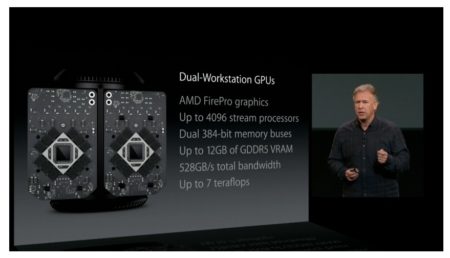The new Mac Pro went on sale in 2013 just as Apple promised, but it really just barely made the self-imposed deadline. Many users clamoring to get their hands on the new workstation class computer were not able to until this month. Yet others found the slight delays valuable as numerous media outlets began to run early units through a battery of scrutinizing performance benchmarks. Now, those who were possibly sitting on the fence or were merely just Mac Pro curious had much more information, taken somewhat from the real world of apps and benchmarks to use to make their final decisions.
Do You Need a New Mac Pro or Not?
So do you need a new Mac Pro or merely want one?
There can be a subtle difference often between those users who want a new Mac Pro and those users who actually need one. Are you more a Prosumer user or a Pro user? Are you a studio-based Pro or a small independent Pro? Does your production pipeline consists of the teamwork and interoperability of others or is it mainly just you?
Advertisement
In this article Architosh is going to establish some guides for making decisions as to acquiring the new Mac Pro and which model. The focus will be on the Mac Pro versus an i7-based iMac as an alternative. We will not be really looking back at the old Mac Pro, though for some that choice also exist.
Companion Pieces
We have two companion articles that have just gone up in the the past few days that shed additional light on the Mac Pro discussion. In one piece Akiko Ashley offers an intelligent Viewpoint on the issue of what Apple thinks a Pro user is and who the new Mac Pro is for? The article is very relevant for studio-based 3D professionals in animation and visual effects (VFX).
The second companion article is a Firm Profile story on the work of Archiform 3D, a highly successful global architectural visualization firm. In that article Steve Bell, its owner and principal, discusses what 3D professionals like him actually need in a workstation and what he thinks of the new Mac Pro. The articles are interesting as they provide counter-points from the perspective of scale. Miss Ashley is arguing her points largely from the perspective of good sized 3D studios, like those found in the TV and film industry, while Mr. Bell offers his views as a small shop with its own private render farm.
First the Fruit Then the Technology
Rather than scrub through a curated review of the benchmarks found around the web we are going to go straight to the heart of the matter so readers can get informed and go straight to decision making. We will scrub through the tests on the second half of this article. (see page 3 if you want to jump to that now)
Let’s start looking at the decision to get a new Mac Pro industry by industry to flush out the issues.
Low Hanging Fruit First
Film Editing
Apple didn’t just wake up one day and say, “let’s make a radical new computer just for fun!” The new Mac Pro is indeed a complete rethinking of what a desktop or workstation computer can be but it was built for a set of purposes. Chief among those is the film editing market and the effort Apple is putting into recapturing the hearts and minds of film pros who lost significant faith in the company after the Final Cut Pro X debacle.
But Final Cut Pro X is making a comeback and early test results show that the new Mac Pro powers through Final Cut Pro X (10.1) with significant advantages over the fastest CTO iMac available or any other Mac around. In the video below–likely the first published independent results showing the new beast in action, the new Mac Pro powers through 18 effects in real-time on 4K video on Final Cut Pro 10.1.
For those outside the film industry–like myself–the shock and awe of this is likely lost or a bit lost at minimum. Apple has made the latest Final Cut Pro X utilize both GPU’s on the new Mac Pro. This early review of Final Cut Pro X 10.1 on the new Mac Pro can be found here. Another review by Macworld magazine also touts the strengths of the new Mac Pro in regards to film editing with Final Cut Pro X 10.1)
For Final Cut Pro X users the new Mac Pro is low-hanging fruit. It’s a no-brainer…as they say. And the numerous test results demonstrate this. If Final Cut Pro X is your livelihood, you likely need a new Mac Pro.
Photoshop Accelerated
A key new technology introduced in Adobe Photoshop CS6 is Adobe’s new Mercury Graphics Engine (MGE). This new graphics engine introduced GPU-accererated features into Photoshop that give it an unprecedented performance in areas like the Oil Paint filter, lighting effects, et cetera. MGE utilizes both OpenGL and OpenCL frameworks, but not the proprietary CUDA from NVIDIA.
For Adobe Photoshop CS6 or Photoshop CC users, you must turn on MGE features in the Photoshop > Preferences menu (Mac). There are different settings of course but choosing Use OpenCL will enable–importantly for many Architosh readers–the Tilt-Shift feature, along with some others like Field Blur. GPU’s must support OpenCL 1.1 and the new Mac Pros certainly do.

01 – The Mac Pro’s twin GPU architecture is one of its most impressive features and Apple is clearly throwing its weight behind GPU compute resources for pro users.
Is Photoshop CS6 or CC really low hanging fruit for making a decision to buy a new Mac Pro? Well, Macworld had Photoshop CC OpenCL test results at 162 seconds on the new Mac Pro compared to a CTO 2013 i7 iMac at 233 seconds. That’s a 140 percent improvement in speed–a huge performance difference. If you work with a lot of the filters and effects that the Adobe Mercury Graphics Engine touches, then the OpenCL performance of the new Mac Pro, in particular, is beneficial. And the larger the files you apply these MGE-based effects to the more important the benefit.
OpenCL Compute
One large area of application is in the area of OpenCL-based parallel computing. We will not talk in too much detail here about all the available OpenCL-based apps but simply list a few that are key in particular to Architosh readers and Mac creatives. Refer to the list below:
- Adobe Photoshop CS6 or CC — Mercury Graphics Engine (5x – 20x faster when OpenCL is available)
- Bullet Physics Engine — Bullet is the number one physics engine in use by professional 3D software packages like Maya and CINEMA 4D and in numerous games
- GIMP — Photo editing tool utilizes OpenCL
- Handbrake — an open source video conversion tool for Mac, Windows and Linux, utilizes OpenCL for video scaling, color space conversion and more
- Indigo Renderer 3.0 — another unbiased, physically based rendering solution that simulates the physics of light to achieve near perfect image realism, this tool works on OS X and uses both OpenCL and/or CUDA
- LuxRender — LuxRender is a physically based and unbiased rendering engine much like Indigo above
- LuxMark — This is an OpenCL benchmark tool that was originally associated with the promotion of LuxRender. LuxRender is included in the Architosh GPU Test Suite
- Mathematica 8 — renowned mathematics and science application
- Motion 5 — this pro app by Apple is part of the Final Cut family and is optimized for multiple GPUs + OpenCL
- Compressor 4 — this pro app by Apple is part of the Final Cut family and is optimized for multiple GPUs + OpenCL
- Pixelmater 3.1 — this image processing Photoshop competitor got an update that leverages the dual GPUs in the new Mac Pro and OpenCL
Importantly, while Adobe’s Mercury Graphics Engine utilizes OpenCL 1.1 and while some of the latest AMD/ATI video cards support this standard, Apple’s Mac Pro is listed as a Conformant Product for OpenCL 1.2, with a dated entry of 27 Nov 2013 for the FirePro D500 Compute Engine, as it is called, which must be the engine behind the D500 and D700, but possibly not the D300.
For users utilizing OpenCL-accererated applications, any apps tapping the benefits and power of OpenCL 1.2 further increase the payoff of the new Mac Pro. All the apps listed above tap the power of OpenCL 1.1 with the possible exception of Apple’s applications which may tap both version 1.1 and 1.2.
In summary, if you spend a lot of time in Final Cut Pro X, use Apple’s Motion and Compressor, if you are a Photoshop CC or CS6 power user, or utilize one or more of the OpenCL compute-intensive apps above then the new Mac Pro will likely greatly accelerate your workflow and be worth every penny in productivity speed-up!
If that is you, you can skip page 2 and go right to page 3 for curated and noted test results from around the web.
next page: Higher Hanging Fruit and Curated Test Results Listing




Reader Comments
#CAD The new Mac Pro A Buyer’s Guide Through the Best Test Results http://t.co/vQ0q7E6PLa
#CAD The new Mac Pro A Buyer’s Guide Through the Best Test Results http://t.co/vQ0q7E6PLa
It it worth noting on this day of features on the Mac Pro and its worthiness in various pro 3D fields (Akiko Ashley piece) and this guide to various applications (industries) that we share this post on fantastic demand for the new killer machine! Good news for Apple.
http://www.canadianreviewer.com/cr/2014/2/18/high-mac-pro-demand-pushes-ship-dates-to-april.html?utm_source=feedburner&utm_medium=feed&utm_campaign=Feed%3A+canadianreviewer%2FnPFE+%28Canadian+Reviewer-+News%2C+views+and+analysis%29
It it worth noting on this day of features on the Mac Pro and its worthiness in various pro 3D fields (Akiko Ashley piece) and this guide to various applications (industries) that we share this post on fantastic demand for the new killer machine! Good news for Apple.
http://www.canadianreviewer.com/cr/2014/2/18/high-mac-pro-demand-pushes-ship-dates-to-april.html?utm_source=feedburner&utm_medium=feed&utm_campaign=Feed%3A+canadianreviewer%2FnPFE+%28Canadian+Reviewer-+News%2C+views+and+analysis%29
Apple’s new Mac Pro dual GPU OpenCL architecture incrementally gaining support among developers http://t.co/k951asKIp6
Apple’s new Mac Pro dual GPU OpenCL architecture incrementally gaining support among developers http://t.co/k951asKIp6
RT @DanielEran: Apple’s new Mac Pro dual GPU OpenCL architecture incrementally gaining support among developers http://t.co/k951asKIp6
RT @DanielEran: Apple’s new Mac Pro dual GPU OpenCL architecture incrementally gaining support among developers http://t.co/k951asKIp6
Hi Anthony,
Thanks for the great information. As an architect, I wonder how the more mundane things like navigating a 3D model in SketchUp, ArchiCAD, or Revit in Parallels would or would not benefit from this. I haven’t seen anything out there yet, that really gets into it. I know Revit in Parallels on an i7 iMac with 32MB of RAM is less than stellar.
Hi Anthony,
Thanks for the great information. As an architect, I wonder how the more mundane things like navigating a 3D model in SketchUp, ArchiCAD, or Revit in Parallels would or would not benefit from this. I haven’t seen anything out there yet, that really gets into it. I know Revit in Parallels on an i7 iMac with 32MB of RAM is less than stellar.
Oops, never mind! I missed page 2. Skipped right over it.
Oops, never mind! I missed page 2. Skipped right over it.
[…] materiały na temat wydajności: The new Mac Pro – A Buyer’s Guide Through the Best Test Results I jeszcze jeden – tym razem 6-core 2010+nVidia GTX 680 z 4-core 2013 z 2xD500: Ostatnio […]
[…] <https://architosh.com/2014/02/the-new-mac-pro-a-buyers-guide-through-the-best-test-results/> […]
Comments are closed.